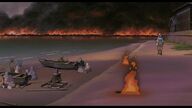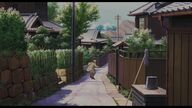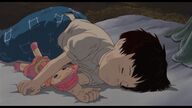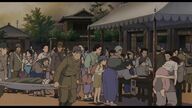In the film, Qingtai, illuminated by the fire, is intertwined with his memories. The tall uniform and hat show his identity as the son of an officer aboard the Maya. However, it was precisely because of the Japanese militarism represented by the Maya that Seita and Setsuko embarked on a tragic road of ruin. When Qingtai learned of Japan's defeat at the bank, the indifference of others also reflected a national characteristic of Japan: to stand up for the weak and surrender to the strong. When the American bomb was dropped on Tokyo, there were flames everywhere, and Seita's memories were also shrouded in the flames of the explosion. After the defeat, the Japanese economy collapsed completely, and all the achievements since the Meiji Restoration were destroyed. In order to be able to eat one more meal and live one more day, Seita, the son of a naval officer of the Imperial Japanese Empire, was forced to steal, rob, kneel on the ground for a sugar cane, and beg for forgiveness. When hunger comes, any shining point of human nature will be dimmed, and the most real side of human beings will be revealed, vividly depicting the national tragedy, social tragedy, and the people's tragedy brought by militarism to Japan. tragedy. At the end of the film, Seita's memory holds Setsuko, staring at the rising Japan after the war, the high-rise buildings in Tokyo, with brilliant lights. This film, shot 25 years ago, has also brought enlightenment to today's Japanese society and us: no matter what war is, it is a human tragedy.
View more about Grave of the Fireflies reviews







